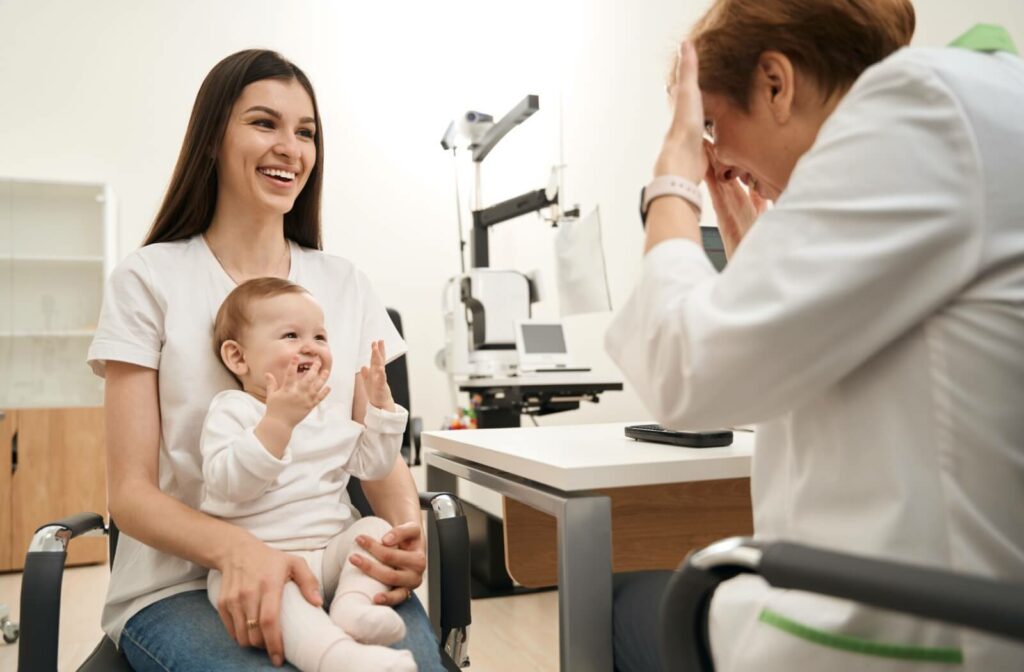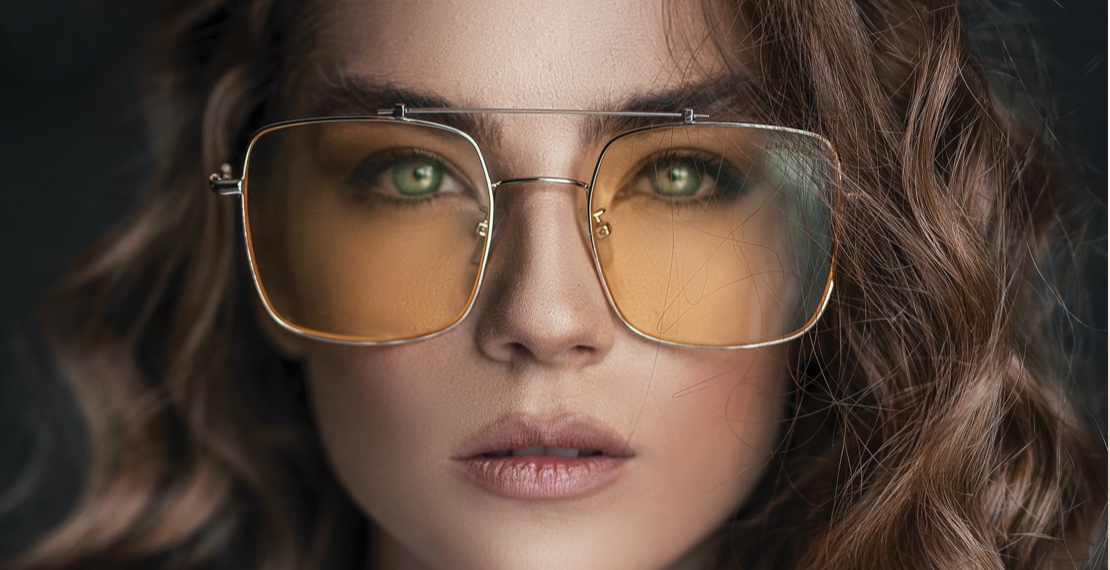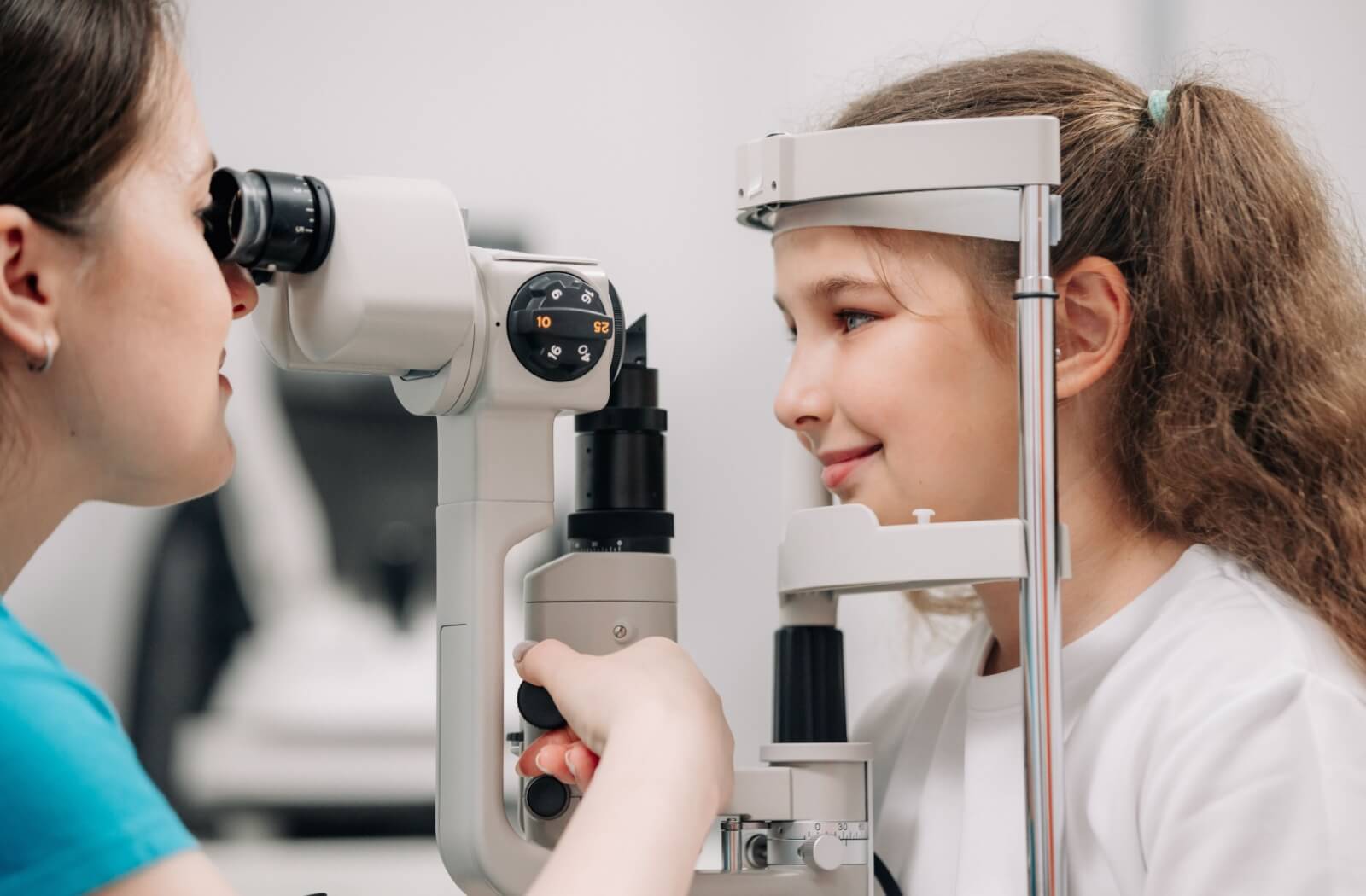Becoming a parent is full of joys and “firsts” as you navigate and get to know this new person. Because we care so much, stress and worry are sure to follow as they grow. As parents, we want to make sure we are doing all the right things – from choosing the right highchair to making sure they are developing normally.
Having a child that has been diagnosed with a vision problem, especially an eye turn (strabismus) can be especially scary. As a doctor that specializes in children’s vision, one of my goals is parent education and open discussion regarding treatment options and how the vision problem may affect their child in the future. If you suspect your child’s vision isn’t developing correctly, rest assured that no age is too young for you to take your child to your optometrist for a comprehensive eye examination.
As children grow, their eyes go through many changes. It is not abnormal for you to observe your infants’ eyes appear to be crossed or wander sometimes. Babies are not born with a fully developed visual system. The millions of neural synapses that the visual system requires is rapidly developing and changing from birth. Creating an environment that encourages proper binocular vision is key for all the future activities that your child will enjoy – everything from riding their bike to getting lost in the world of that new library book.
Strabismus or eye misalignment, is a medical condition where the eyes are not “teamed” or pointing in the same direction at the same time. You may be more familiar with terms like “eye turn” or “crossed eyes”. If not treated in a timely manner, longstanding strabismus can lead to amblyopia, reading difficulties and reduced depth perception. After the initial 3 to 4 months after birth, if you observe that one eye constantly turns or the frequency is increasing, it may be a sign of strabismus.
There are many ways to treat strabismus. Those include eyeglasses, contact lenses and prism lenses. Vision therapy is also very effective at improving strabismus, amblyopia, post concussion vision syndrome and patients who have binocular vision dysfunction.
How Children’s Eyes Develop
From birth, your child’s visual system is developing and undergoes change constantly. Your child’s vision is rapidly developing as synapses and connections between the eyes and brain are being established. Vision simultaneously develops alongside your child’s other senses – hearing, proprioception, vestibular input are all integrating rapidly between birth and 3 years old.
At birth, your child’s vision is not fully developed. Visual acuity, eye movement, focusing and eye position will continue to improve and become more refined through repetition and learning from the world around them. Although each child develops at their own pace, there are some key vision milestones that parents should be aware of.
Providing an environment that allows the opportunity for vision to develop is key. How I explain that to parents is that activities like tummy time, high contrast objects and toys, free space play are all essential for the development of vision. I recommend avoiding all hand held screens and to limit baby “containers” as they restrict movement and engagement of not only vision, but speech and vestibular input.
The 4-Month Mark
Around 4 months, you should start to observe your child accurately following you as you walk across the room. You should also notice that your child is starting to reach for and discover objects. When your child reaches for something – whether that is a new toy or something ordinary like a pen laying on the table, what most people don’t realize is that the child has already been mentally practicing picking up that object many times before they actually complete the action. The full visual motor movement of picking up that pen only takes place after the child has “practiced” using visual planning. So by the time your baby grabs that toy, they’ve already been practicing using motor planning skills that are innate to them. That’s where that proud look of accomplishment comes from as joy and victory spread across their face!
The 8-Month Mark
Around 8 months, your child’s vision should have improved to a point where they can now see things from a distance and will be excited to explore their surroundings. You may notice them crawling toward objects they are interested in or playing with toys that require eye-hand coordination. Milestones like crawling are essential to the development of bilateral coordination of the right and left hemispheres of the brain, which helps for future activities like eye tracking and reading. Children who skip developmental milestones can later struggle with reading and comprehension.
At this stage,their depth perception is also starting to develop. Stereopis, or depth perception allows you to accurately judge the distance between objects. Everything from walking to parking your car in the parking space requires depth perception.
For some parents they will see an eye turn when their child is tired or when they look in a certain direction or distance. If the right and left eyes are not lined up together, the child will have double vision – they just don’t have the words to tell you yet! If the eye turn continues, depth perception will not develop properly. This is where early intervention is key for proper binocular vision development.
The 1–2 Year Mark
Between 1 and 2 years, you should notice significant improvement in your child’s vision. Alongside eye focusing, eye teaming and eye tracking, visual perceptual skills are also developing. Your child should start to be able to identify shapes, sizes, objects and recognize faces. Visual perceptual skills allow you to organize and interpret the incoming visual information and give what you see meaning. There are many visual perceptual skills, but the core 7 include: visual memory, visual sequential memory, visual form constancy, visual figure ground, visual spatial relations, visual closure and visual discrimination.
Supporting vision development with purposeful play is something every parent can do. Modern technology and automated toys are passive ways to entertain and get information but do not allow the child to discover and effectively develop visual skills that are necessary for everyday life. Going back to the basics with games like blocks, puzzles, sorting and reading to your child all allow the room for the child to learn and grow. Activities like scribbling with crayons and building a tower with blocks help develop fine motor skills and integrate visual skills like eye teaming and tracking.
What Is Strabismus?
Strabismus, or eye misalignment, is a medical condition where the eyes are not “teamed” or pointing in the same direction at the same time. You may be more familiar with terms like “eye turn” or “crossed eyes”.
Strabismus is a neurological condition that can be developmental, acquired or can occur with patients who’s vision decompensates over time. When considering strabismus, there are many variations that can involve one (monocular) or both eyes (binocular). The eye can turn inwards (esotropia), outwards (exotropia), up (hypertropia) or down (hypotropia). Frequency can be intermittent, constant or alternating. The angle or magnitude of the eye turn can be worse at distance or more noticeable at near or when looking in certain directions. In other words, strabismus can be complicated to understand. It requires a doctor that is proficient in neurology and strabismus and has the ability to effectively communicate with patients the correct diagnosis and treatment options.
In my practice, since we specialize in binocular vision and offer optometric vision therapy rehabilitation services, I see more strabismus than your average eye doctor. It takes not only skill to diagnose, but effective communication in order to explain the diagnosis and treatment options to the patient.
In a normal binocular visual system, the position and movement of the right and left eyes via cranial nerve 3, 4 and 6 are coordinated through complex nerve pathways that extend from the eye muscles to the primary visual cortex. Within the visual cortex, CN 3,4 and 6 are “linked” – this is why you don’t have to think about moving your right eye and then your left eye when you are reading – they move together!
Since the brain is what essentially “sees” and each eye receives an image or picture. These images are almost the same, except for their position – they are slightly offset which allows us to see stereopsis or depth perception. As information flows from the retina to visual cortex, those identical images are simultaneously overlapped and processed, creating one clear, single image. If one eye is not exactly lined up with the other, then the patient should experience double vision. Sometimes, a patient will complain of double vision where the images are separated by a greater distance and other times the images appear “shadowy” and the patient will complain of blurred vision instead of what is actually happening – they are seeing double!
Patients with strabismus may be symptomatic and not realize that their binocular vision is what is making it difficult keeping their place when they read or being able to judge where they are parking their car in a space. For some patients, they have not made the connection that their reduced binocular (two-eyed) vision is what reduces their efficiency when reading a book or when there are balance issues. The opposite is also true, especially in longstanding cases of strabismus where the brain is suppressing vision in one eye.
Imagine how long it would take to intake information if you had to constantly second guess which eye you were looking through. This is how binocular vision problems can impact, reading comprehension, attention and processing information. Vision is so much more than reading letters on the eye chart – vision is the “boss” of the senses and when it operates efficiently, it enhances our life. When vision is not operating well, then it can cause other ongoing issues that get overlooked as vision problems.
For adults who struggle with strabismus, they are often more verbal with their vision complaints and struggle with everything from adapting to new glasses, to difficulty parking their car or reading spreadsheets at work. Parents, on the other hand, often struggle with understanding how their child’s strabismus is impacting their life – both within the classroom and for bigger global concepts like social acceptance or cosmetic concerns.
or crossed eyes, is a vision condition that makes it difficult, or impossible, to align both eyes simultaneously under standard vision conditions. The eyes don’t work as a coordinated team; instead, one turns in a different direction independent of the other. Strabismus can develop in children at a young age, typically before age five. Various factors, such as genetics, development, or neurological conditions, can contribute to strabismus.
Though crossed eyes don’t seem like a big problem, they can significantly impact your child’s vision, ability to read and learn in the classroom and even cause emotional distress due to cosmetic concerns. In many cases, strabismus can even lead to amblyopia (lazy eye). Because one eye isn’t aligned correctly, the brain will begin to prioritize the stronger eye and ignore the weaker eye, leading to significantly worsening vision or vision loss in the ignored eye. In cases of amblyopia, 20/20 vision does not develop either due to high refractive error (refractive amblyopia) or the eye turn (strabismic amblyopia). Suppression occurs as a solution to the ongoing double vision or blur – essentially the brain will ignore an eye causing ongoing blurred vision.
Strabismus won’t go away on its own.
How to Treat Crossed Eyes in Babies

With strabismus being a common condition in young children, parents need to know how to identify and treat it early on. Most of the time, your pediatrician will examine your child’s eye using objective observation or more frequently an autorefractor that gives the technician a basic overview if there is a concern (high prescription or an eye turn). I can’t emphasize this enough, because I’ve seen it countless times over my 16 years of practice, but this is not an eye exam! Your optometrist will use special pediatric acuity charts, retinoscopy, ophthalmoscopy and cycloplegic eye drops in order to determine eye position and if your child needs glasses. Early prevention is key. If you observe that something appears “off” with your child, do not wait for you pediatrician or nurse to find it!
The first step is to schedule an appointment with an optometrist who specializes in children’s vision. When you call to make your initial appointment, make sure you tell the receptionist that you have concerns about strabismus.
Treatment options are available for all ages and include glasses, prism lenses, bifocals, in office optometric vision therapy and at home developmental programs for even our youngest patients.
Eyeglasses or Contact Lenses
For some patients, wearing the correct eyeglasses or contact lens prescription can improve strabismus. By correcting visual acuity and balancing clarity between the right and left eyes, the brain has the opportunity to use both eyes together instead of relying only on the eye that has the clearer image. In cases of accommodative esotropia (eyes cross due to high hyperopia), parents can expect to see improved eye position with the glasses on compared to when they are removed. By reducing how much the child is focusing (accommodating), the eyes return to a straighter and more relaxed position. In cases of exotropia (eye turns outward), the position of the eye can also improve since each eye would receive a clear image, allowing the brain to use both eyes together.
Prism Lenses
Prism lenses are used in various ways in my practice. Prism can be beneficial not only for patients who have strabismus, but for patients who struggle with vision problems after a concussion, traumatic brain injury or other neurological conditions that can affect binocular vision – Myasthenia Gravis, Graves Disease, Multiple Sclerosis just to name a few. I like to describe prism as improving the ability of the eyes to focus together by moving the image to another area of the retina. Prescribing prism is one of my favorite tools for patients who struggle with binocular issues, as the right prescription can improve symptoms and quality of life quickly.
Vision Therapy
Optometric vision therapy is a noninvasive medical treatment for binocular vision problems that can interfere with reading, learning and enjoying activities of everyday life. Our visual system is composed of a complex neurological process that requires coordinated eye focusing, eye tracking and alignment to achieve clear, single vision. Patients who struggle with accommodative dysfunction (eye focusing), oculomotor dysfunction (eye tracking) and eye alignment problems (strabismus, amblyopia) can benefit from optometric vision therapy. Treatment involves activities designed to improve the flow of visual information from eye to brain allowing the patient to process central and peripheral visual information, improving eye coordination, fusion/depth perception and visual processing.
Surgery
In some cases, strabismus surgery may be necessary to adjust the length or position of the muscles. It is important for the patient to understand that surgery is not a quick fix for strabismus and often requires multiple surgeries. I explain it to my patients that there is no way to predict how much to cut the eye muscle since the eyes are changing position constantly – in all directions and distances. Often, after strabismus surgery the eye turn will change or continue since the brain does not know that the eye muscles were repositioned. Discussing expectations with the surgeon is essential in order to understand all possible outcomes. Optometric vision therapy after strabismus surgery improves the outcome for developing binocular vision and depth perception.
What Is Vision Therapy?
Vision therapy is a noninvasive medical treatment for binocular vision problems that can interfere with reading, learning and enjoying activities of everyday life. Our visual system is composed of a complex neurological process that requires coordinated eye focusing, eye tracking and alignment to achieve clear, single vision. Patients who struggle with accommodative dysfunction (eye focusing), oculomotor dysfunction (eye tracking), eye alignment problems (strabismus, amblyopia) and traumatic brain injury can benefit from optometric vision therapy. Treatment involves one on one activities with your vision therapist that are designed to improve binocular vision skills, eye tracking, eye alignment and focusing. Patients who sustain traumatic brain injury can also suffer from Post Concussion Vision Syndrome and benefit greatly from optometric vision therapy.
The Importance of Early Detection
Strabismus isn’t just a cosmetic issue; it’s a condition that can affect you and your child’s vision for life. If you suspect a problem, please reach out to your optometrist. No age is too young to get an eye exam. Our team at Bella Vision is here to help. Book a children’s eye exam with us today, and let’s work together to make a world of difference for your child’s future.


























